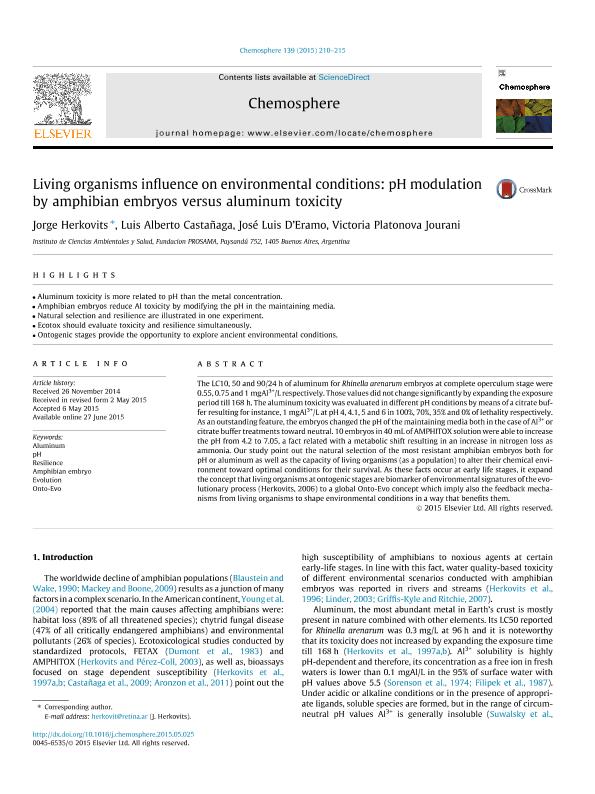Mostrar el registro sencillo del ítem
dc.contributor.author
Herkovits, Jorge

dc.contributor.author
D'eramo, Jose Luis

dc.contributor.author
Castañaga, Luis Alfredo

dc.contributor.author
Platonova Jourani, Victoria
dc.date.available
2018-04-10T19:27:51Z
dc.date.issued
2015-06
dc.identifier.citation
Herkovits, Jorge; D'eramo, Jose Luis; Castañaga, Luis Alfredo; Platonova Jourani, Victoria; Living organisms influence on environmental conditions: pH modulation by amphibian embryos versus aluminum toxicity; Pergamon-Elsevier Science Ltd; Chemosphere; 139; 6-2015; 210-215
dc.identifier.issn
0045-6535
dc.identifier.uri
http://hdl.handle.net/11336/41577
dc.description.abstract
The LC10, 50 and 90/24 h of aluminum for Rhinella arenarum embryos at complete operculum stage were 0.55, 0.75 and 1 mgAl3+/L respectively. Those values did not change significantly by expanding the exposure period till 168 h. The aluminum toxicity was evaluated in different pH conditions by means of a citrate buffer resulting for instance, 1 mgAl3+/L at pH 4, 4.1, 5 and 6 in 100%, 70%, 35% and 0% of lethality respectively. As an outstanding feature, the embryos changed the pH of the maintaining media both in the case of Al3+ or citrate buffer treatments toward neutral. 10 embryos in 40 mL of AMPHITOX solution were able to increase the pH from 4.2 to 7.05, a fact related with a metabolic shift resulting in an increase in nitrogen loss as ammonia. Our study point out the natural selection of the most resistant amphibian embryos both for pH or aluminum as well as the capacity of living organisms (as a population) to alter their chemical environment toward optimal conditions for their survival. As these facts occur at early life stages, it expand the concept that living organisms at ontogenic stages are biomarker of environmental signatures of the evolutionary process (Herkovits, 2006) to a global Onto-Evo concept which imply also the feedback mechanisms from living organisms to shape environmental conditions in a way that benefits them.
dc.format
application/pdf
dc.language.iso
eng
dc.publisher
Pergamon-Elsevier Science Ltd

dc.rights
info:eu-repo/semantics/openAccess
dc.rights.uri
https://creativecommons.org/licenses/by-nc-nd/2.5/ar/
dc.subject
Aluminium
dc.subject
Resilience
dc.subject
Environmental
dc.subject
Amphibian
dc.subject
Ph
dc.subject
Oxygen Consumption
dc.subject.classification
Meteorología y Ciencias Atmosféricas

dc.subject.classification
Ciencias de la Tierra y relacionadas con el Medio Ambiente

dc.subject.classification
CIENCIAS NATURALES Y EXACTAS

dc.title
Living organisms influence on environmental conditions: pH modulation by amphibian embryos versus aluminum toxicity
dc.type
info:eu-repo/semantics/article
dc.type
info:ar-repo/semantics/artículo
dc.type
info:eu-repo/semantics/publishedVersion
dc.date.updated
2018-04-10T14:18:22Z
dc.journal.volume
139
dc.journal.pagination
210-215
dc.journal.pais
Estados Unidos

dc.description.fil
Fil: Herkovits, Jorge. Fundación Pro Salud y Medio Ambiente. Instituto de Ciencias Ambientales y Salud; Argentina. Consejo Nacional de Investigaciones Científicas y Técnicas; Argentina
dc.description.fil
Fil: D'eramo, Jose Luis. Fundación Pro Salud y Medio Ambiente. Instituto de Ciencias Ambientales y Salud; Argentina. Consejo Nacional de Investigaciones Científicas y Técnicas; Argentina
dc.description.fil
Fil: Castañaga, Luis Alfredo. Fundación Pro Salud y Medio Ambiente. Instituto de Ciencias Ambientales y Salud; Argentina. Consejo Nacional de Investigaciones Científicas y Técnicas; Argentina
dc.description.fil
Fil: Platonova Jourani, Victoria. Fundación Pro Salud y Medio Ambiente. Instituto de Ciencias Ambientales y Salud; Argentina
dc.journal.title
Chemosphere

dc.relation.alternativeid
info:eu-repo/semantics/altIdentifier/doi/http://dx.doi.org/ 10.1016/j.chemosphere.2015.05.025
dc.relation.alternativeid
info:eu-repo/semantics/altIdentifier/url/https://www.sciencedirect.com/science/article/pii/S0045653515004889
Archivos asociados
